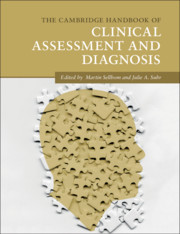Book contents
- The Cambridge Handbook of Clinical Assessment and Diagnosis
- The Cambridge Handbook of Clinical Assessment and Diagnosis
- Copyright page
- Contents
- Figures
- Tables
- Contributors
- Acknowledgments
- 1 Introduction to the Handbook of Clinical Assessment and Diagnosis
- Part I General Issues in Clinical Assessment and Diagnosis
- Part II Specific Clinical Assessment Methods
- 10 Clinical Interviewing
- 11 Multi-Informant Assessment of Psychopathology from Preschool through Old Age
- 12 Intellectual Assessment
- 13 Achievement Assessment
- 14 Using Vocational Assessment Tests
- 15 Neuropsychological Testing and Assessment
- 16 Minnesota Multiphasic Personality Inventory-2-Restructured Form (MMPI-2-RF)
- 17 Personality Assessment Inventory
- 18 The Millon Clinical Multiaxial Inventory-IV (MCMI-IV)
- 19 Self-Report Scales for Common Mental Disorders
- 20 Performance-Based Techniques
- Part III Assessment and Diagnosis of Specific Mental Disorders
- Part IV Clinical Assessment in Specific Settings
- Index
- References
18 - The Millon Clinical Multiaxial Inventory-IV (MCMI-IV)
from Part II - Specific Clinical Assessment Methods
Published online by Cambridge University Press: 06 December 2019
- The Cambridge Handbook of Clinical Assessment and Diagnosis
- The Cambridge Handbook of Clinical Assessment and Diagnosis
- Copyright page
- Contents
- Figures
- Tables
- Contributors
- Acknowledgments
- 1 Introduction to the Handbook of Clinical Assessment and Diagnosis
- Part I General Issues in Clinical Assessment and Diagnosis
- Part II Specific Clinical Assessment Methods
- 10 Clinical Interviewing
- 11 Multi-Informant Assessment of Psychopathology from Preschool through Old Age
- 12 Intellectual Assessment
- 13 Achievement Assessment
- 14 Using Vocational Assessment Tests
- 15 Neuropsychological Testing and Assessment
- 16 Minnesota Multiphasic Personality Inventory-2-Restructured Form (MMPI-2-RF)
- 17 Personality Assessment Inventory
- 18 The Millon Clinical Multiaxial Inventory-IV (MCMI-IV)
- 19 Self-Report Scales for Common Mental Disorders
- 20 Performance-Based Techniques
- Part III Assessment and Diagnosis of Specific Mental Disorders
- Part IV Clinical Assessment in Specific Settings
- Index
- References
Summary
The MCMI-IV is frequently deployed in personality diagnosis to foster incremental validity, as its constructs correspond closely to established DSM-5 constructs. However, its use is constrained to this basic function with clinicians who are not sufficiently trained in the underlying theory of the test, the nuances of the constructs, or both. This chapter seeks to provide a primer for Millon’s Evolutionary Theory, specifically as it relates to a more thorough application in assessment and treatment with the MCMI-IV. This includes a contextual view of the MCMI-IV as it differs from other objective measures, as well as an overview of interpretive procedures from basic administration to more advanced theory integration. It also informs the clinician of potential for therapeutic enhancement using the instrument’s findings. Advantages and disadvantages of the MCMI-IV’s deductive approach in test construction and empirical grounding are discussed, as are strengths and limitations.
Keywords
- Type
- Chapter
- Information
- The Cambridge Handbook of Clinical Assessment and Diagnosis , pp. 249 - 262Publisher: Cambridge University PressPrint publication year: 2019
References
- 2
- Cited by



